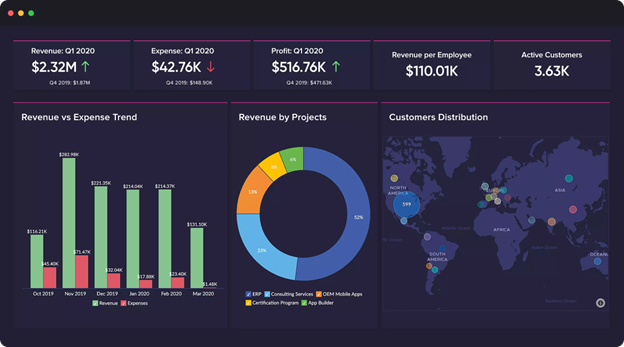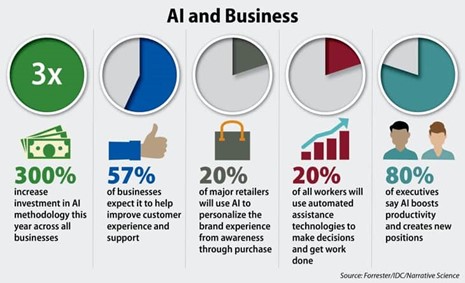In the digital age, every business is loaded with information and data – but only a few are able to leverage the data they collect into meaningful insights for growth. That’s because raw data needs to be processed, compiled, and analyzed into insightful information.
Thanks to emerging technologies like Machine Learning and Artificial Intelligence, businesses now have the power to extract rich insights from operational data and make informed decisions. We are by far sure that every business today is either trying to or wants to make intelligent use of the data at its disposal. So, we’ll not get into reasons why you should consider investing in Business Intelligence. Without beating about the bush, we’ll simply tell you what growth with business intelligence looks like, reveal what end-to and then get to the core of what having full-stack Business Intelligence capabilities looks like.
Table of Contents
Growing Business with Business Intelligence
Do you know, as per the reports by Forbes, 54% of enterprises believed that cloud-based Business Intelligence was vital to their current and future initiatives for their business? This shows only one thing and that is business leaders believe in BI and they are growing at a rapid speed.
Recently, while sharing more light on Business Intelligence, the CIO also shared an interesting thought in their magazine. “Although business intelligence does not tell business users what to do or what will happen if they take a certain course, neither is BI only about generating reports. Rather, BI offers a way for people to examine data to understand trends and derive insights.”
If you’re still not convinced, here are some benefits businesses are already driving from Business Intelligence Software.
- Better Business Understanding: The rich insights help you understand business operations, customers and market trends in a better way to make informed and confident strategic choices for your business.
- Optimized Performances: It improves operational efficiency by optimizing processes, identifying bottlenecks and reducing costs.
- Competitive Advantage: Amid fluctuating markets, BI on board gives you stability and competitive advantage, letting you focus on business operations rather than competition.
Now that we’ve stated for the record what the power of BI is – let’s get to business and talk about all that full-stack BI software entails.
Unleashing the Power of BI: What Full-Stack Business Intelligence Software Should Have
Full-stack business intelligence comes with both front-end and back-end features. A back-end feature to prepare the data in the back end and create a data repository for analysis and a process to represent the analytics data and provide dashboard reports with deeper business understanding.
Let’s discuss the key features a full-stack Business Intelligence Software should have to help you leverage business data and perform efficient business operations.
Comprehensive Dashboards
Wouldn’t it be amazing to get a quick holistic look at the screen with visuals and numbers and be assured that your entire business is operating efficiently and there are no setbacks at the moment?
The purpose of dashboards is to help you make intelligent strategies and improve business decisions. With the capability of creating and customizing dashboards, you can create modules, charts and graphs of the operations running in your business in real time. A self-service facility would let anyone access the data, customize their own analysis, and build a culture of analysis.
Security At Its Peak
In addition to its visual data representation capabilities, a vital aspect of a business intelligence solution lies in its ability to securely store and facilitate access to data. Collecting, filtering, cleaning and organizing data can be arduous and time-consuming and a solution can streamline these processes and safeguard against unauthorized access.
Moreover, you must prioritize data privacy compliance, particularly with regulations like the General Data Protection Regulation (GDPR). It is imperative to select a business intelligence platform with the required accreditations and robust safeguards to uphold data security, governance and compliance standards.
Driving Business with Data
Once you have strategized the kind of data you would collect for your business and resources of the same, the magic lies in the analytical insights. An ideal analytics platform offers optimized native connections to your data sources, regardless of their location, ensuring quick access for faster analysis.
Flexibility is crucial when you are making critical decisions for your business. The business intelligence software allows you to deploy your analytics in the cloud, on-premises or through a hosted solution. It also seamlessly integrates with your existing data strategy, eliminating the need for disruptive changes or additional product purchases.
Moreover, the platform should easily embed into your company portals and other enterprise applications, enabling users to access analytics where they are. By prioritizing flexibility, you can avoid unnecessary costs and enhance the overall ownership experience of your business intelligence program and chosen BI platform.
Automation for the Win
One of the use cases of AI-ML technologies is automation. With AI-ML integration, Business Intelligence helps you with repetitive tasks such as data organization and de-duplication. This not only helps your employees prioritize their tasks but leaves no room for human errors and saves time and money.
BI tools help you identify the pain points, bottlenecks and inefficiencies in different departments such as manufacturing, operations and sales. With forecasting capability, predictive analysis lets you eventually resolve problem areas and streamline marketing and sales operations. It also makes you understand customer behavior and upcoming trends, equipping businesses with the knowledge to stay ahead.
Disaster Recovery
Using “what if” analysis empowers you to evaluate the potential outcomes of crucial decisions before implementation. By leveraging existing data, you can formulate strategies to effectively meet business targets and plan a strategy for disaster recovery.
Additionally, artificial intelligence (AI) can be harnessed to simulate future scenarios and assess the potential impacts of various actions. Such analysis lets you make informed decisions for your operations and future endeavors.
So, now you know what ideal business intelligent software looks like and the functionality you should have on board. Don’t forget to integrate them while adopting your tool.
To Sum Up
If you really want to make your business smart, you should adopt business intelligence software and strategize the processes. With a business intelligence tool and an upskilled team on board, you can enhance your operational efficiency and make accurate decisions.
It would be essential to determine your company’s objective and strategize the type and source of your data. As the tool gets on board, you should be all set to keep the business running while monitoring and achieving goals.
As the ability to transform raw data into actionable intelligence helps you stay competitive and drive growth, adapting to market changes becomes vital. While concepts like Edge Computing, API-based Integrated systems, and AI-ML will only make Business Intelligence more advanced and efficient in coming years, business leaders need to stay on their toes and updated with new trends and technologies.
Businesses that want to thrive in the current competitive market must move into data and analytical functions, and must adopt full-stack Business Intelligence Software. Have you opted for one yet?



